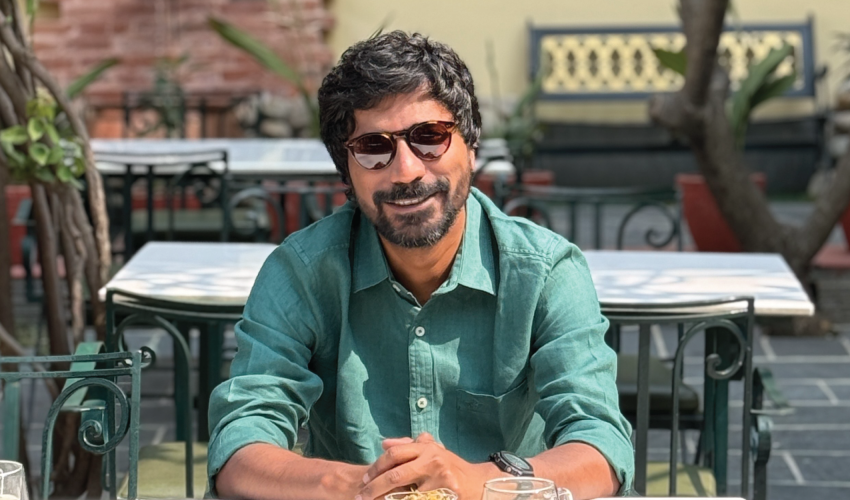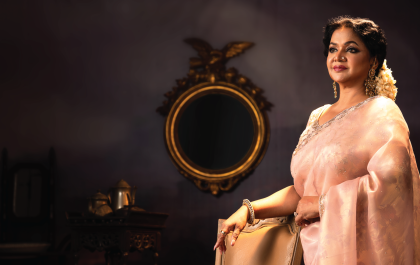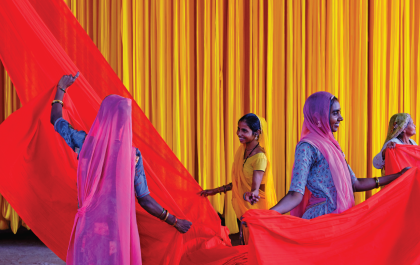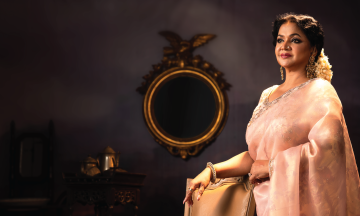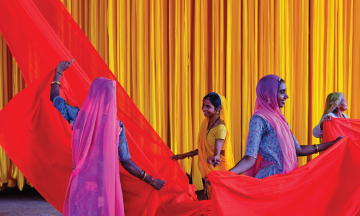By Ayman Anika
Shankha Dasgupta didn’t burst onto the scene – he quietly slipped in. Made a few mistakes, scrapped a few scripts, and somehow ended up directing award-winning commercials and running his own production house. Not bad for someone who never had a mentor, never assisted a big-name director, and learned most things the hard way (read: trial, error, repeat).
Over the years, he’s directed hundreds of commercials and launched Filmy Features, his own production house. But it was Guti – a slow-burn web series that explores the layered life of a drug-smuggling mother – and Priyo Maloti, a poetic and quietly intense film, that proved he wasn’t here just to sell soap and mobile data.
With MWB, the talented director opens up about his fascinating journey – one that began not with a big break but with bold steps taken entirely on his own terms.
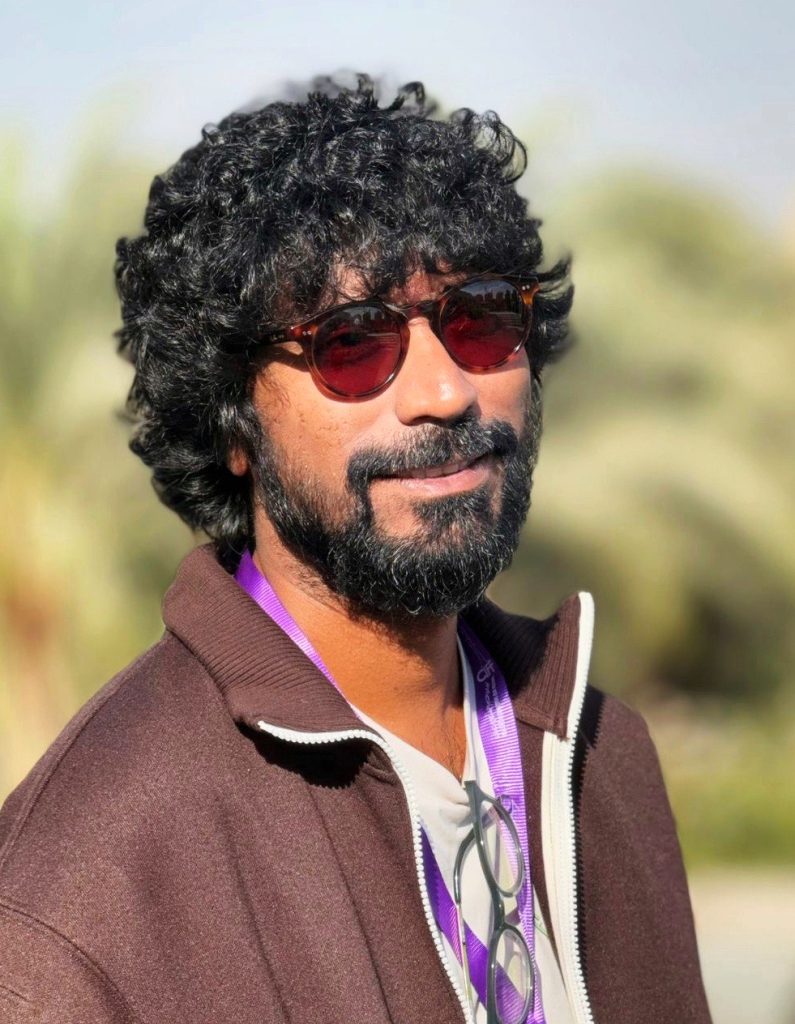
Could you paint a picture of your childhood?
My childhood was split between two very distinct places – Cumilla and Barisal – and both shaped me in unique ways. My father was posted in Cumilla for work, so I spent the early years of my life there. Later, when I was in class five, we moved back to Barisal. So, in many ways, I had the privilege of growing up with the flavors of both urban and rural life.
Barisal, especially, played a significant role in shaping my worldview and, eventually, my filmmaking journey. The atmosphere of the village was very different – there was space to explore, interact with all kinds of people, and experience life in a raw, unfiltered way. Those experiences left a deep impression on me.
I also grew up under the care of my eldest uncle, who was a politician. Because he had poor eyesight, I would read the newspaper aloud to him every day, starting from class five or six. This daily ritual made me incredibly curious about the world. I began reading the entire paper, not just the headlines, which helped me absorb stories, politics, and societal issues at a young age.
Another vivid memory is writing letters to my parents and brother every week. Since I lived away from them, and we didn’t have mobile phones or texting back then, letters were the only way to communicate. That practice didn’t just help me stay connected – it nurtured my habit of writing and expressing myself thoughtfully, something that became very important later in life.
Looking back, I feel like these moments – the historic home, the village life, the newspapers, and the weekly letters – all slowly pushed me towards story-telling, even before I realized that’s what I was doing.
Were films a part of your upbringing, or did your love for cinema come later?
Cinema wasn’t part of my life during my early years – not in any conscious way. But, you know, to be a filmmaker, one needs to develop a certain power of observation. That ability to observe deeply – how people live, how they behave – is key. Because, at the end of the day, we draw stories from real life, from the characters we encounter.
In that sense, I was privileged. I got to meet people from a wide range of backgrounds, experienced different lifestyles – rural, urban, political, and cultural. That exposure shaped me as a person long before I knew what I wanted to do.
As I mentioned earlier, I used to read newspapers aloud to my uncle from a young age. Back then, I wanted to become a journalist. And I did pursue that path. That experience helped sharpen my journalistic lens. But during my time in journalism, I realized something important: while writing is powerful, I felt an urge to tell stories visually.
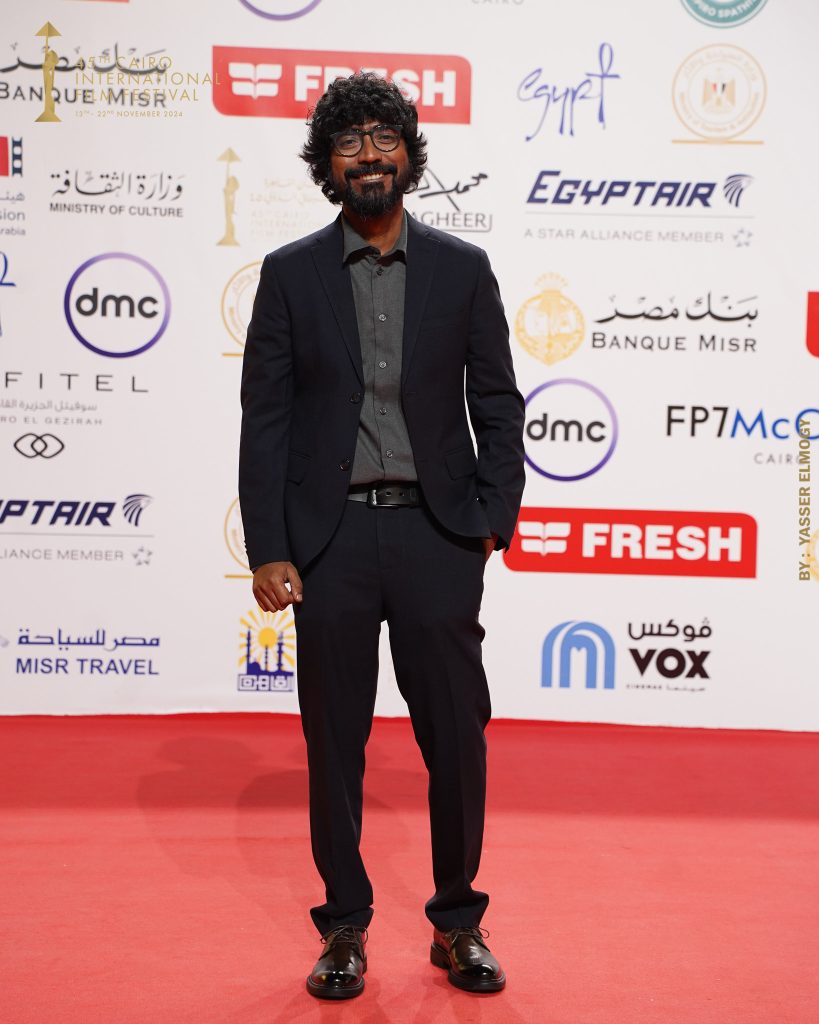
In journalism, you tell a story or report news primarily through words. But as I kept doing it, I started feeling – what if I could express these stories visually too? What if the visuals could capture the emotional layers and context that words sometimes fail to deliver?
Yes, it’s true that in television journalism, we do use visuals – but they’re usually limited to footage that supports a report. As a journalist, there are many things you want to include but simply can’t because of the medium’s structure.
Yet, behind every news story, there’s a human story.
That’s what I wanted to tell – through visuals. That desire, that hunger, began to grow inside me. I realized that if I became a filmmaker, I could express those untold aspects – the raw emotions, the unspoken struggles – through a cinematic lens. I could finally tell the stories I truly wanted to tell.
You’ve been involved in both journalism and the film industry. Everyone faces challenges in the early days – what were your initial struggles like?
When I first entered the audio-visual industry, I was a complete outsider – no film background, no family connections. Naturally, that came with skepticism. People questioned whether I could really pull it off, and I constantly had to prove myself.
I started with TV dramas – seven or eight of them – and they were, quite frankly, failures. I didn’t understand the industry, the system, or how things worked behind the scenes. I struggled to fit into an ecosystem that didn’t align with my vision. I saw those stories as films, not TV content, and that mismatch held me back.
Eventually, I stepped away from television drama. Around 2012–2013, I reassessed everything and shifted to television commercials. That move changed everything.
Commercials brought structure, discipline, and a demand for clear, creative reasoning. Since then, I’ve made 300 to 400 commercials, working with some of the best talents in the field. That experience shaped me. Advertising became the most effective training ground for me as a filmmaker. That’s where I found my rhythm. That’s where I learned.
Did you have any mentors who helped you along the way?
I didn’t have a mentor in the traditional sense, but I’ve been inspired by many. Filmmakers like Tareque Masud, Asghar Farhadi, Neeraj Ghaywan, Abdullah Mohammad Saad, and my friend Adnan Al Rajeev have all influenced me in different ways. Even younger filmmakers like Touqir Shaik have inspired me with their fresh perspectives and fearless story-telling. Observing their approach to narrative and execution has been incredibly enriching.
Though I never formally assisted any of them, I started my journey independently – learning everything on the go, mostly through trial and error. Each project has taught me something new. I’ve always tried to make new mistakes instead of repeating old ones. That’s been my rule for growth – and it’s what’s helped me keep moving forward.
What inspired you to centre the narrative around Sultana in Guti, a woman entangled in drug smuggling?
The idea for this story first came to me while working on one of my short films, which centered around a sex worker. That experience made me reflect on how quickly we label people without ever trying to understand the life behind the label.
I started thinking about women who don’t hold “respectable” jobs by societal standards. What if we looked past the profession and focused on the person?
Around that time, a senior writer and mentor shared a story about women who smuggled drugs by hiding them inside their bodies. That struck me – not just the act, but the woman behind it.
And that’s how Guti began. We didn’t want to make a story about a drug mule. We wanted to tell the story of Sultana – a mother, a wife, a sister. Yes, smuggling is part of it, but it lives in the subtext. The heart of the story is about her humanity, her quiet resilience, and the lengths she goes to for her family.
That’s how the idea took root – evolving from a thought into a screenplay and, eventually, into the full project.
Could you tell us about your collaboration with Mehazabien Chowdhury in Priyo Maloti –how did the character of Maloti take shape, and how did you work together to bring her to life?
The idea for Priyo Maloti began in the summer of 2023. During that time, there were several incidents of fires breaking out around the city – it’s something that, unfortunately, tends to happen frequently during the hotter months here.
That got me thinking: What if such an incident happened to a Hindu family? What would it look like, especially considering the rituals Hindu families follow? And what if the characters – like Maloti or Palash – belonged to a lower socio-economic background? In a city like ours, when individuals from marginalized or vulnerable communities face crises, how much support do they actually receive from our societal structures, from the way our “social security” system works?
That question became the foundation of the story. I imagined placing a Hindu character in such a volatile, exposed situation and began to explore what the consequences would be.
Once I had the initial story fleshed out, I shared it with my friend Adnan. I told him, “I’ve developed something, and I want to turn this into a film.” Without missing a beat, he said, “Let’s do it.”
Now, as I thought about the character of Maloti, I realized that Mehazabien had a face, a screen presence, and an emotional depth that resonated with how I envisioned Maloti. There was a closeness between the imagined character and the kind of intensity Mehazabien carries. That’s when I knew – she was the one I wanted to collaborate with.
So, I narrated the story to her, and immediately she responded, “Let’s do this.”
From there, I began developing the screenplay and building the pre-production framework. My process usually involves collaborating with artists from a very early stage because I want them to grow with the character, to be part of the evolution.
And Mehazabien was onboard from the beginning. I kept her updated regularly – sharing new drafts, changes, and visual ideas. She’s the kind of artist who genuinely values being part of the process. She likes to have a voice, to contribute her thoughts and perspectives – and she was kind and generous enough to do exactly that.
Gradually, as the project progressed, she began to develop a sense of ownership over both the story and the character. She wasn’t just playing Maloti – she became Maloti.
I personally don’t direct “performances.” I try to capture what it feels like when someone lives a character. That’s what I aim to shoot.
And over the course of three to four months – through regular script readings, rehearsals, and blockings – she immersed herself in Maloti’s world. So, by the time we actually started shooting, nothing felt new to her. She was already in character. When the camera rolled, she wasn’t acting – she was simply being Maloti.
I must say, she did a fantastic job. Her performance was honest, unfiltered, and exactly the way we had envisioned it. I truly believe she wasn’t just performing the role – she was living it.
Everything you see in Priyo Maloti comes from my own life. There isn’t a single scene I haven’t experienced in some way. The characters of Maloti and Palash are deeply inspired by my parents – the way they lived, their values, their quiet strength. I’ve tried to reflect their mannerisms and way of life through these characters.
Even the little details are rooted in real memories. That’s why the story feels so authentic – it’s lived, not imagined.
I’ve also drawn from the subtle, everyday discrimination I witnessed growing up. Like landlords refusing to rent once they found out we were Hindu, or being mocked as a child for temple bells sounding like ice cream carts. These incidents stay with you. Priyo Maloti gave me a way to express them – with honesty and care.
Would you share your experience of screening your film at the Cairo International Film Festival? How did it feel, and did it shift your perspective on global filmmaking?
To be honest, this was my first time attending a film festival of this scale. The Cairo International Film Festival is the biggest in the Africa and Middle East region. What struck me most was the kind of audience it attracted – passionate film lovers and professionals from across the world – Jordan, Bahrain, Saudi Arabia, India, Africa, Europe – you name it.
What I realized there is that the nationality of a film doesn’t really matter. Nor does its technical flair. What matters is how local and authentic the story feels. And that’s exactly what people saw in Priyo Maloti. They found it incredibly original and sincere.
Many of them told me, “This is such a local story, but at the same time, it’s deeply global.” Because what we’ve portrayed in the film – whether it’s bureaucratic struggles or social realities – those issues exist everywhere, just in different forms. The bureaucratic mess may look one way in our country, another way in America, or differently still in Europe. But it’s there. And that shared struggle made the story universally relatable.
Another thing that really moved me was hearing people say they felt like they were inside Dhaka for two hours. They could see, feel, and even smell the city through the film. That kind of feedback, shared face-to-face, was incredibly meaningful.
Of course, walking a red carpet was completely new to me – the flashlights, the glamor, the whole atmosphere – it was surreal.
But perhaps the most special moment was meeting our jury president, Danis Tanović, an Oscar-winning filmmaker whose debut film No Man’s Land (2001) won Best Foreign Language Film at the Academy Awards. He praised Priyo Maloti so generously, and we ended up having a 30-minute conversation about the film. For someone like me – who admires him so much – that was one of the most unforgettable moments of my life.
That entire experience was truly the best thing that’s happened with Maloti so far.
Is there a genre you haven’t explored yet but would love to?
I’d say I haven’t explored too many genres just yet. So far, I’ve mostly worked within drama –especially social dramas. Still, drama remains my favorite genre. There’s a comfort there.
But now, I feel like I want to branch out. I’d love to explore romance – maybe even a hardcore thriller. Hopefully, I’ll get the chance to do that in some upcoming projects.
What’s next for Shankha Dasgupta?
Right now, I’m developing a project for Chorki – I’m working on the story and screenplay. I’m also developing another project for the OTT platform Sony LIV. These two are currently in the works.
As for my next feature film, I’m still exploring ideas. I haven’t committed to one yet – I’m taking my time to nurture the concepts and see which one resonates the most before jumping in.
Photo Credit: Courtesy




